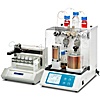One thing I love about working with a team of chemists is that they’re constantly giving me the opportunity to expand my knowledge about their world (unfortunately they’re not so inclined to investigate the technical side of design or not put their sulky face on when I point out the merits of further administrative work but you can’t have everything, right?).
When Sir Harry Kroto passed away, aged 76, on 30th April and the team mentioned how renowned he was I felt the need to find out more. I was rather amazed by this inspiring individual…
Sir Harry was actually born in Wisbech, a town just down the road from our head office here in Cambridgeshire, to Edith and Heinz Krotoschiner who were refugess from Germany (the family name was later shortened to Kroto). Edith had been evacuated to Wisbech during the second world war while his father was interned as an enemy alien on the Isle of Man (home of the TT races of course!). After the war the family moved to Bolton where they settled and his father re-established the toy balloon business he had originally run in Berlin. Young Harry went to the local school and excelled in art and sports in addition to the traditional academic subjects. Encouraged by his teacher, Harry Heaney, Sir Harry went on to Sheffield University to study for a chemistry degree and then a PhD in molecular spectroscopy.
It may surprise you to know that during his time at Sheffield he also was the art editor of “Arrows” – the University student magazine, played tennis for the University team (reaching the UAU finals twice!) and was President of the Student Athletics Council (from 1963 to 1964). I guess we would describe him now as the perfect “all-rounder”! He was a great participator of the chemistry department pantomimes, involved in writing, directing and performing them and apparently based several of his fun sketches on Fawlty Towers and the Monty Python group.
In 1985 whilst working as Professor of Chemistry at the University of Sussex, Sir Harry teamed up with Rick Smalley and Robert Curl who were both professors of chemistry at Rice University, Houston, Texas, to laser-vaporise carbon in laboratory experiments designed to simulate the chemistry of stars and interstellar space. Their results seemed to indicate that they had made an unexpected molecular species comprising 60 carbon atoms. Carbon was of course known to exist as diamond or graphite but not as a small molecule. This needed completely new thinking!
Sir Harry was able to draw on his artistic skills and a knowledge of graphic design. He proposed that C60 was made up of a mixture of pentagons and hexagons in a shape now recognised by us as a football shape. US architect and inventor, Buckminster Fuller, had designed structures that were very similar to this shape and thus the discovery, C60, became known as “buckyballs” or, more formally, as buckminsterfullerenes. This discovery was closely followed by that of larger carbon cage structures and nanotubes, arguably sparking off the whole new area of nanotechnology.
He was awarded the Nobel prize in chemistry in 1996 (shared with his two co-chemists) and was also knighted. He became the archetypal Nobel Prize Winner, driven to inspire the next generation of scientists. Word has it that his undergrad lectures were so brilliant that when he got to the end his audience would actually applaud so he was obviously doing something right!
The world of chemistry needs innovators and creators and I’m so glad to have learned more about Sir Harry Kroto, who would have absolutely met this criteria!





